Hirschsprung’s disease - Study guides, Class notes & Summaries
Looking for the best study guides, study notes and summaries about Hirschsprung’s disease? On this page you'll find 338 study documents about Hirschsprung’s disease.
Page 3 out of 338 results
Sort by
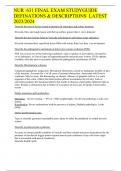
-
NUR 631 FINAL EXAM STUDYGUIDE DEFINATIONS & DESCRIPTIONS LATEST 2023/2024
- Exam (elaborations) • 16 pages • 2023
-
- $8.99
- + learn more
Describe the type of lesions found in psoriasis & seborrheic and actinic keratosis. Elevated, firm, and rough lesion with flat top surface greater than 1 cm in diameter Describe the skin lesions found in Varicella (chickenpox) and herpes zoster (shingles). Elevated circumscribed, superficial lesion filled with serous fluid, less than 1 cm in diameter Describe the pathogenetic mechanism of polycystic ovarian syndrome (POS). POS has at least two of the following conditions: oligo-ovulation...
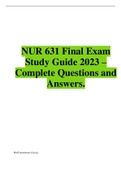
-
NUR 631 Final Exam Study Guide 2023 – Complete Questions and Answers | Latest Guide 2023
- Exam (elaborations) • 40 pages • 2023
-
- $14.99
- + learn more
NUR 631 Final Exam Study Guide 2023 – Complete Questions and Answers. Describe the type of lesions found in psoriasis & seborrheic and actinic keratosis. Elevated, firm, and rough lesion with flat top surface greater than 1 cm in diameter Describe the skin lesions found in Varicella (chickenpox) and herpes zoster (shingles). Elevated circumscribed, superficial lesion filled with serous fluid, less than 1 cm in diameter Describe the pathogenetic mechanism of polycystic ovarian syndrome (POS). P...
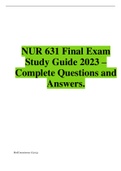
-
NUR 631 Final Exam Study Guide 2023 – Complete Questions and Answers | Latest Guide 2023
- Exam (elaborations) • 40 pages • 2023
-
- $13.99
- + learn more
NUR 631 Final Exam Study Guide 2023 – Complete Questions and Answers. Describe the type of lesions found in psoriasis & seborrheic and actinic keratosis. Elevated, firm, and rough lesion with flat top surface greater than 1 cm in diameter Describe the skin lesions found in Varicella (chickenpox) and herpes zoster (shingles). Elevated circumscribed, superficial lesion filled with serous fluid, less than 1 cm in diameter Describe the pathogenetic mechanism of polycystic ovarian syndrome (POS). P...
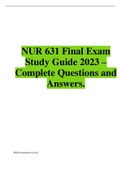
-
NUR 631 Final Exam Study Guide 2023 – Complete Questions and Answers | Latest Guide 2023
- Exam (elaborations) • 40 pages • 2023
-
- $13.99
- + learn more
NUR 631 Final Exam Study Guide 2023 – Complete Questions and Answers. Describe the type of lesions found in psoriasis & seborrheic and actinic keratosis. Elevated, firm, and rough lesion with flat top surface greater than 1 cm in diameter Describe the skin lesions found in Varicella (chickenpox) and herpes zoster (shingles). Elevated circumscribed, superficial lesion filled with serous fluid, less than 1 cm in diameter Describe the pathogenetic mechanism of polycystic ovarian syndrome (POS). P...
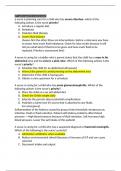
-
ATI_peds_questions and answers
- Exam (elaborations) • 24 pages • 2023
- Available in package deal
-
- $18.49
- + learn more
a nurse is planning care for a child who has severe diarrhea. which of the following actions is the nurse priority? A. Introduce a regular diet B. Rehydrate C. Maintain fluid therapy D. Assess fluid balance (Assess first the other three are interventions, before u intervene you have to assess how much fluid imbalance. Check for labs results because it will tell you what kind of fluid is to be given and how much fluid to be replaced. Priority is assessment first) A nurse is caring for a t...
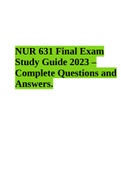
-
NUR 631 Final Exam Study Guide 2023 – Complete Questions and Answers.
- Exam (elaborations) • 28 pages • 2023
- Available in package deal
-
- $14.49
- + learn more
NUR 631 Final Exam Study Guide 2023 – Complete Questions and Answers. Describe the type of lesions found in psoriasis & seborrheic and actinic keratosis. Elevated, firm, and rough lesion with flat top surface greater than 1 cm in diameter Describe the skin lesions found in Varicella (chickenpox) and herpes zoster (shingles). Elevated circumscribed, superficial lesion filled with serous fluid, less than 1 cm in diameter Describe the pathogenetic mechanism of polycystic ovarian syndrome (...
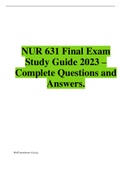
-
NUR 631 Final Exam Study Guide 2023 – Complete Questions and Answers | Latest Guide 2023
- Exam (elaborations) • 40 pages • 2023
-
- $15.99
- + learn more
NUR 631 Final Exam Study Guide 2023 – Complete Questions and Answers. Describe the type of lesions found in psoriasis & seborrheic and actinic keratosis. Elevated, firm, and rough lesion with flat top surface greater than 1 cm in diameter Describe the skin lesions found in Varicella (chickenpox) and herpes zoster (shingles). Elevated circumscribed, superficial lesion filled with serous fluid, less than 1 cm in diameter Describe the pathogenetic mechanism of polycystic ovarian syndrome (POS). P...

-
ATI PEDIATRICS QUESTIONS AND ANSWERS
- Exam (elaborations) • 24 pages • 2023
-
- $9.99
- + learn more
ATI PEDIATRICS QUESTIONS AND ANSWERS a nurse is planning care for a child who has severe diarrhea. which of the following actions is the nurse priority? A. Introduce a regular diet B. Rehydrate C. Maintain fluid therapy D. Assess fluid balance (Assess first the other three are interventions, before u intervene you have to assess how much fluid imbalance. Check for labs results because it will tell you what kind of fluid is to be given and how much fluid to be replaced. Priority is assessme...
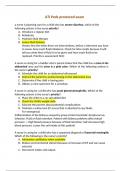
-
ATI Peds proctored exam
- Exam (elaborations) • 24 pages • 2023
- Available in package deal
-
- $18.49
- + learn more
a nurse is planning care for a child who has severe diarrhea. which of the following actions is the nurse priority? A. Introduce a regular diet B. Rehydrate C. Maintain fluid therapy D. Assess fluid balance (Assess first the other three are interventions, before u intervene you have to assess how much fluid imbalance. Check for labs results because it will tell you what kind of fluid is to be given and how much fluid to be replaced. Priority is assessment first) A nurse is caring for a t...
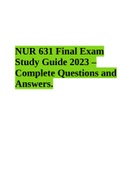
-
NUR 631 Final Exam Study Guide 2023 – Complete Questions and Answers.
- Exam (elaborations) • 28 pages • 2023
-
Available in package deal
-
- $12.99
- + learn more
NUR 631 Final Exam Study Guide 2023 – Complete Questions and Answers. Describe the pathogenetic mechanism of polycystic ovarian syndrome (POS). POS has at least two of the following conditions: oligo-ovulation or anovulation, elevated lev- els of androgens, or clinical signs of hyperandrogenism and polycystic ovaries. Of the options available, only this answer accurately defines the pathogenetic mechanisms of POS. Describe Hirschsprung’s disease. Congenital aganglionic megacolon. Mech...

Did you know that on average a seller on Stuvia earns $82 per month selling study resources? Hmm, hint, hint. Discover all about earning on Stuvia


